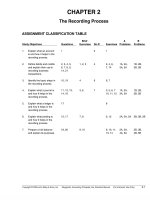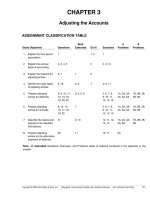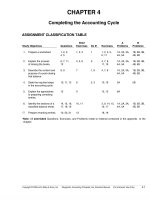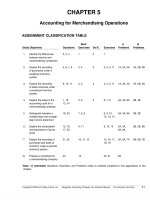Solution manual accounting principles 8e by kieso ch05
Bạn đang xem bản rút gọn của tài liệu. Xem và tải ngay bản đầy đủ của tài liệu tại đây (274.61 KB, 78 trang )
CHAPTER 5
Accounting for Merchandising Operations
ASSIGNMENT CLASSIFICATION TABLE
Study Objectives
Questions
Brief
Exercises
Exercises
A
Problems
B
Problems
*1.
Identify the differences
between service and
merchandising companies.
2, 3, 4
1
1
*2.
Explain the recording
of purchases under a
perpetual inventory
system.
5, 6, 7, 8
2, 4
2, 3, 4, 10
1A, 2A, 4A
1B, 2B, 4B
*3.
Explain the recording
of sales revenues under
a perpetual inventory
system.
9, 10, 11
2, 3
3, 4,
5, 10
1A, 2A, 4A
1B, 2B, 4B
*4.
Explain the steps in the
accounting cycle for a
merchandising company.
1, 12,
13, 14
5, 6
6, 7, 8
3A, 4A, 8A
3B, 4B, 8B
*5.
Distinguish between a
multiple-step and a singlestep income statement.
18, 19, 20
7, 8, 9
6, 9, 11, 12
2A, 3A, 8A
2B, 3B, 8B
*6.
Explain the computation
and importance of gross
profit.
15, 16, 17
9, 11
11, 12
2A, 5A, 6A,
8A
2B, 5B, 6B,
8B
7.
Determine cost of goods
sold under a periodic
system.
21
10, 11
13, 14, 15
5A, 6A, 7A
5B, 6B, 7B
*8.
Explain the recording of
purchases and sales under
a periodic inventory system.
22
12
16, 17
7A
7B
*9.
Prepare a worksheet for
a merchandising company.
23
13
18, 19
8A
*Note: All asterisked Questions, Exercises, and Problems relate to material contained in the appendices
to the chapter.
5-1
ASSIGNMENT CHARACTERISTICS TABLE
Problem
Number
Description
Difficulty
Level
Time
Allotted (min.)
1A
Journalize purchase and sales transactions under
a perpetual inventory system.
Simple
20–30
2A
Journalize, post, and prepare a partial income statement.
Simple
30–40
3A
Prepare financial statements and adjusting and
closing entries.
Moderate
40–50
4A
Journalize, post, and prepare a trial balance.
Simple
30–40
5A
Determine cost of goods sold and gross profit under
periodic approach.
Moderate
40–50
6A
Calculate missing amounts and assess profitability.
Moderate
20–30
Simple
30–40
Moderate
50–60
*7A
Journalize, post, and prepare trial balance and partial
income statement using periodic approach.
*8A
Complete accounting cycle beginning with a worksheet.
1B
Journalize purchase and sales transactions under
a perpetual inventory system.
Simple
20–30
2B
Journalize, post, and prepare a partial income statement.
Simple
30–40
3B
Prepare financial statements and adjusting and
closing entries.
Moderate
40–50
4B
Journalize, post, and prepare a trial balance.
Simple
30–40
5B
Determine cost of goods sold and gross profit under
periodic approach.
Moderate
40–50
6B
Calculate missing amounts and assess profitability.
Moderate
20–30
Simple
30–40
*7B
Journalize, post, and prepare trial balance and partial
income statement using periodic approach.
5-2
5-3
Distinguish between a
multiple-step and a singlestep income statement.
Explain the computation and
importance of gross profit.
Determine cost of goods sold Q5-21
under a periodic system.
Explain the recording of
purchases and sales under
a periodic inventory system.
Prepare a worksheet for
a merchandising company.
*5.
*6.
*7.
*8.
*9.
Broadening Your Perspective
Explain the steps in the
accounting cycle for a
merchandising company.
*4.
Q5-23
BE5-13
Q5-18
Q5-19
Q5-10
Explain the recording of
sales revenues under a
perpetual inventory system.
*3.
Q5-15
Q5-16
BE5-9
BE5-11
Q5-17
E5-15
P5-5A
P5-5B
E5-11
E5-12
P5-2A
P5-2B
E5-9
E5-11
E5-12
E5-6
E5-7
E5-8
E5-4
E5-5
P5-1A
P5-2A
E5-3
E5-4
P5-1A
P5-2A
Communication Exploring the Web
E5-18
E5-19
Q5-22
BE5-12
E5-16
BE5-10
BE5-11
E5-13
BE5-7
BE5-9
E5-6
Q5-13
BE5-5
BE5-6
Q5-11
BE5-2
BE5-3
E5-3
Q5-8
BE5-2
BE5-4
E5-2
E5-1 BE5-1
Application
Q5-20
BE5-8
Q5-1
Q5-12
Q5-14
Q5-6
Q5-7
Q5-5
Explain the recording of
purchases under a perpetual
inventory system.
*2.
Q5-3
Q5-4
Identify the differences
between service and
merchandising companies.
Q5-2
Knowledge Comprehension
*1.
Study Objective
P5-8A
E5-17
P5-7A
P5-7B
Synthesis
Decision Making
Financial Reporting
Across the
Comparative Analysis
Decision Making Across Organization
the Organization
P5-7A E5-14
P5-7B P5-6A
P5-6B
P5-5A P5-6A
P5-5B P5-6B
P5-8A
P5-2A P5-3A
P5-2B P5-3B
P5-8A
P5-4A P5-3A
P5-8A P5-3B
P5-4B
P5-4A Q5-9
P5-1B E5-10
P5-2B
P5-4B
P5-1B E5-10
P5-2B
P5-4A
P5-4B
Analysis
All About You
Comparative Analysis
Financial Reporting
Decision Making Across
the Organization
Ethics Case
Evaluation
Correlation Chart between Bloom’s Taxonomy, Study Objectives and End-of-Chapter Exercises and Problems
BLOOM'S TAXONOMY TABLE
ANSWERS TO QUESTIONS
1.
(a) Disagree. The steps in the accounting cycle are the same for both a merchandising company
and a service company.
(b) The measurement of income is conceptually the same. In both types of companies, net
income (or loss) results from the matching of expenses with revenues.
2.
The normal operating cycle for a merchandising company is likely to be longer than in a service
company because inventory must first be purchased and sold, and then the receivables must be
collected.
3.
(a) The components of revenues and expenses differ as follows:
Merchandising
Revenues
Expenses
(b)
Service
Fees, Rents, etc.
Operating (only)
Sales
Cost of Goods Sold and Operating
The income measurement process is as follows:
Sales
Revenue
Less
Cost of
Goods
Sold
Gross
Profit
Equals
Less
Operating
Expenses
Equals
Net
Income
4.
Income measurement for a merchandising company differs from a service company as follows:
(a) sales are the primary source of revenue and (b) expenses are divided into two main
categories: cost of goods sold and operating expenses.
5.
In a perpetual inventory system, cost of goods sold is determined each time a sale occurs.
6.
The letters FOB mean Free on Board. FOB shipping point means that goods are placed free on
board the carrier by the seller. The buyer then pays the freight and debits Merchandise Inventory.
FOB destination means that the goods are placed free on board to the buyer’s place of business.
Thus, the seller pays the freight and debits Freight-out.
7.
Credit terms of 2/10, n/30 mean that a 2% cash discount may be taken if payment is made within
10 days of the invoice date; otherwise, the invoice price, less any returns, is due 30 days from the
invoice date.
8.
July 24
Accounts Payable ($2,000 – $200) .........................................................
Merchandise Inventory ($1,800 X 2%) ..........................................
Cash ($1,800 – $36)..........................................................................
1,800
36
1,764
9.
Agree. In accordance with the revenue recognition principle, sales revenues are generally considered to be earned when the goods are transferred from the seller to the buyer; that is, when
the exchange transaction occurs. The earning of revenue is not dependent on the collection of
credit sales.
10.
(a) The primary source documents are: (1) cash sales—cash register tapes and (2) credit sales—
sales invoice.
5-4
Questions Chapter 5 (Continued)
(b)
The entries are:
Debit
Cash sales—
Credit sales—
11.
July 19
Cash..........................................................................
Sales ................................................................
Cost of Goods Sold ................................................
Merchandise Inventory .................................
XX
Accounts Receivable .............................................
Sales ................................................................
Cost of Goods Sold ................................................
Merchandise Inventory .................................
XX
Cash ($800 – $16)............................................................................
Sales Discounts ($800 X 2%) ........................................................
Accounts Receivable ($900 – $100)....................................
Credit
XX
XX
XX
XX
XX
XX
784
16
800
12.
The perpetual inventory records for merchandise inventory may be incorrect due to a variety of
causes such as recording errors, theft, or waste.
13.
Two closing entries are required:
(1)
(2)
Sales ..............................................................................................................
Income Summary ...............................................................................
200,000
Income Summary ........................................................................................
Cost of Goods Sold............................................................................
145,000
200,000
145,000
14.
Of the merchandising accounts, only Merchandise Inventory will appear in the post-closing trial
balance.
15.
Sales revenues .........................................................................................................................
Cost of goods sold ...................................................................................................................
Gross profit ................................................................................................................................
$105,000
70,000
$ 35,000
Gross profit rate: $35,000 ÷ $105,000 = 33.3%
16.
Gross profit ................................................................................................................................
Less: Net income.....................................................................................................................
Operating expenses.................................................................................................................
17.
There are three distinguishing features in the income statement of a merchandising company:
(1) a sales revenues section, (2) a cost of goods sold section, and (3) gross profit.
5-5
$370,000
240,000
$130,000
Questions Chapter 5 (Continued)
*18.
(a)
The operating activities part of the income statement has three sections: sales revenues,
cost of goods sold, and operating expenses.
(b)
The nonoperating activities part consists of two sections: other revenues and gains, and
other expenses and losses.
*19.
The functional groupings are selling and administrative. The problem with functional groupings
is that some expenses may have to be allocated between the groups.
*20.
The single-step income statement differs from the multiple-step income statement in that: (1) all data
are classified into two categories: revenues and expenses, and (2) only one step, subtracting
total expenses from total revenues, is required in determining net income (or net loss).
*21.
Accounts
Added/Deducted
Purchase Returns and Allowances
Purchase Discounts
Freight-in
Deducted
Deducted
Added
*22. July 24
*23.
Accounts Payable ($3,000 – $200) ..............................................................
Purchase Discounts ($2,800 X 2%) ....................................................
Cash ($2,800 – $56)...............................................................................
2,800
56
2,744
The columns are:
(a) Merchandise Inventory—Trial Balance (Dr.), Adjusted Trial Balance (Dr.), and Balance
Sheet (Dr.).
(b) Cost of Goods Sold—Trial Balance (Dr.), Adjusted Trial Balance (Dr.), and Income
Statement (Dr.).
5-6
SOLUTIONS TO BRIEF EXERCISES
BRIEF EXERCISE 5-1
(a) Cost of goods sold = $45,000 ($75,000 – $30,000).
Operating expenses = $19,200 ($30,000 – $10,800).
(b) Gross profit = $38,000 ($108,000 – $70,000).
Operating expenses = $8,500 ($38,000 – $29,500).
(c) Sales = $151,500 ($71,900 + $79,600).
Net income = $40,100 ($79,600 – $39,500).
BRIEF EXERCISE 5-2
Hollins Company
Merchandise Inventory ..............................................
Accounts Payable...............................................
Gordon Company
Accounts Receivable..................................................
Sales .......................................................................
Cost of Goods Sold.....................................................
Merchandise Inventory .....................................
780
780
780
780
520
520
BRIEF EXERCISE 5-3
(a) Accounts Receivable..................................................
Sales .......................................................................
Cost of Goods Sold.....................................................
Merchandise Inventory .....................................
900,000
(b) Sales Returns and Allowances ...............................
Accounts Receivable.........................................
Merchandise Inventory ..............................................
Cost of Goods Sold............................................
120,000
5-7
900,000
620,000
620,000
120,000
90,000
90,000
BRIEF EXERCISE 5-3 (Continued)
(c) Cash ($780,000 – $15,600)........................................
Sales Discounts ($780,000 X 2%) ..........................
Accounts Receivable ........................................
($900,000 – $120,000)
764,400
15,600
780,000
BRIEF EXERCISE 5-4
(a) Merchandise Inventory..............................................
Accounts Payable ..............................................
900,000
(b) Accounts Payable.......................................................
Merchandise Inventory.....................................
120,000
(c) Accounts Payable ($900,000 – $120,000)............
Merchandise Inventory.....................................
($780,000 X 2%)
Cash ($780,000 – $15,600)...............................
780,000
900,000
120,000
15,600
764,400
BRIEF EXERCISE 5-5
Cost of Goods Sold.............................................................
Merchandise Inventory..............................................
1,500
1,500
BRIEF EXERCISE 5-6
Sales.........................................................................................
Income Summary ........................................................
195,000
Income Summary .................................................................
Cost of Goods Sold ....................................................
Sales Discounts...........................................................
107,000
5-8
195,000
105,000
2,000
BRIEF EXERCISE 5-7
MAULDER COMPANY
Income Statement (Partial)
For the Month Ended October 31, 2008
Sales revenues
Sales ($280,000 + $100,000) .....................................
Less: Sales returns and allowances ....................
Sales discounts...............................................
Net sales .........................................................................
$380,000
$11,000
13,000
24,000
$356,000
BRIEF EXERCISE 5-8
As the name suggests, numerous steps are required in determining net
income in a multiple-step income statement. In contrast, only one step is
required to compute net income in a single-step income statement. A multiplestep statement has five sections whereas a single-step statement has only
two sections. The multiple-step statement provides more detail than a singlestep statement, but net income is the same under both statements.
Some of the differences in presentation can be seen from the comparative
information presented below.
(1) Multiple-Step Income Statement
a.
b.
c.
Item
Gain on sale of equipment
Casualty loss from vandalism
Cost of goods sold
Section
Other revenues and gains
Other expenses and losses
Cost of goods sold
(2) Single-Step Income Statement
Item
a.
b.
c.
Section
Gain on sale of equipment
Casualty loss from vandalism
Cost of goods sold
Revenues
Expenses
Expenses
BRIEF EXERCISE 5-9
(a) Net sales = $510,000 – $15,000 = $495,000.
(b) Gross profit = $495,000 – $350,000 = $145,000.
5-9
BRIEF EXERCISE 5-9 (Continued)
(c) Income from operations = $145,000 – $70,000 – $40,000 = $35,000.
(d)
Gross profit rate = $145,000 ÷ $495,000 = 29.3%.
BRIEF EXERCISE 5-10
Purchases...................................................................................
Less: Purchase returns and allowances ........................
Purchase discounts...................................................
Net purchases ...........................................................................
$450,000
$11,000
8,000
Net purchases ...........................................................................
Add: Freight-in ........................................................................
Cost of goods purchased......................................................
19,000
$431,000
$431,000
16,000
$447,000
BRIEF EXERCISE 5-11
Net sales .....................................................................................
Beginning inventory................................................................
Add: Cost of goods purchased*........................................
Cost of goods available for sale .........................................
Ending inventory......................................................................
Cost of goods sold ..................................................................
Gross profit................................................................................
$630,000
$ 60,000
447,000
507,000
90,000
417,000
$213,000
*Information taken from Brief Exercise 5-10.
*BRIEF EXERCISE 5-12
(a)
(b)
(c)
Purchases........................................................................ 1,000,000
Accounts Payable .................................................
Accounts Payable .........................................................
Purchase Returns and Allowances.................
130,000
Accounts Payable ($1,000,000 – $130,000)...........
Purchase Discounts ($870,000 X 2%).............
Cash ($870,000 – $17,400)..................................
870,000
5-10
1,000,000
130,000
17,400
852,600
*BRIEF EXERCISE 5-13
(a) Cash: Trial balance debit column; Adjusted trial balance debit column;
Balance sheet debit column.
(b) Merchandise inventory: Trial balance debit column; Adjusted trial balance
debit column; Balance sheet debit column.
(c) Sales: Trial balance credit column; Adjusted trial balance credit column,
Income statement credit column.
(d) Cost of goods sold: Trial balance debit column, Adjusted trial balance
debit column, Income statement debit column.
5-11
SOLUTIONS TO EXERCISES
EXERCISE 5-1
1.
True.
2.
False. For merchandising company, sales less cost of goods sold is
called gross profit.
3.
4.
True.
True.
5.
False. The operating cycle of a merchandising company differs from that
that of a service company. The operating cycle of a merchandising
company is ordinarily longer.
False. In a periodic inventory system, no detailed inventory records of
goods on hand are maintained.
True.
6.
7.
8.
False. A perpetual inventory system provides better control over inventories than a periodic system.
EXERCISE 5-2
(a) (1) April 5
Merchandise Inventory........................
Accounts Payable........................
25,000
Merchandise Inventory........................
Cash .................................................
900
Equipment ...............................................
Accounts Payable........................
26,000
Accounts Payable.................................
Merchandise Inventory...............
4,000
Accounts Payable.................................
($25,000 – $4,000)
Merchandise Inventory...............
[($25,000 – $4,000) X 2%]
Cash ($21,000 – $420).................
21,000
Accounts Payable ...........................................
Cash............................................................
21,000
(2) April 6
(3) April 7
(4) April 8
(5) April 15
(b) May 4
5-12
25,000
900
26,000
4,000
420
20,580
21,000
EXERCISE 5-3
Sept. 6
9
10
12
14
20
Merchandise Inventory (80 X $20).....................
Cash ...................................................................
1,600
Merchandise Inventory .........................................
Cash ...................................................................
80
Accounts Payable (2 X $21).................................
Merchandise Inventory ................................
42
Accounts Receivable (26 X $31) ........................
Sales...................................................................
Cost of Goods Sold (26 X $21) ...........................
Merchandise Inventory ................................
806
Sales Returns and Allowances .........................
Accounts Receivable...................................
Merchandise Inventory ........................................
Cost of Goods Sold......................................
31
Accounts Receivable (30 X $31) .......................
Sales..................................................................
Cost of Goods Sold (30 X $21) ..........................
Merchandise Inventory ...............................
1,600
80
42
806
546
546
31
21
21
930
930
630
630
EXERCISE 5-4
(a) June 10
11
12
19
Merchandise Inventory................................
Accounts Payable ................................
8,000
Merchandise Inventory................................
Cash..........................................................
400
Accounts Payable .........................................
Merchandise Inventory.......................
300
Accounts Payable ($8,000 – $300)...........
Merchandise Inventory.......................
($7,700 X 2%)
Cash ($7,700 – $154) ...........................
7,700
5-13
8,000
400
300
154
7,546
EXERCISE 5-4 (Continued)
(b) June 10
12
19
Accounts Receivable...................................
Sales ........................................................
Cost of Goods Sold......................................
Merchandise Inventory ......................
8,000
Sales Returns and Allowances ................
Accounts Receivable..........................
Merchandise Inventory ...............................
Cost of Goods Sold.............................
300
Cash ($7,700 – $154)....................................
Sales Discounts ($7,700 X 2%).................
Accounts Receivable..........................
($8,000 – $300)
7,546
154
8,000
5,000
5,000
300
150
150
7,700
EXERCISE 5-5
(a) 1.
Accounts Receivable...........................
Sales.................................................
Cost of Goods Sold..............................
Merchandise Inventory ..............
500,000
Sales Returns and Allowances ........
Accounts Receivable..................
27,000
Cash ($473,000 – $9,460)....................
Sales Discounts ....................................
[($500,000 – $27,000) X 2%]
Accounts Receivable..................
($500,000 – $27,000)
463,540
9,460
(b) Cash .......................................................................................
Accounts Receivable ...............................................
($500,000 – $27,000)
473,000
2.
3.
Dec. 3
Dec. 8
Dec. 13
5-14
500,000
350,000
350,000
27,000
473,000
473,000
EXERCISE 5-6
(a)
ZAMBRANA COMPANY
Income Statement (Partial)
For the Year Ended October 31, 2008
Sales revenues
Sales ..........................................................................
Less: Sales returns and allowances ..............
Sales discounts.........................................
Net sales ...................................................................
$800,000
$25,000
15,000
40,000
$760,000
Note: Freight-out is a selling expense.
(b) (1) Oct. 31
Sales ......................................................
Income Summary......................
800,000
Income Summary...............................
Sales Returns and
Allowances.............................
Sales Discounts ........................
40,000
(a) Cost of Goods Sold........................................................
Merchandise Inventory ........................................
900
(b) Sales ...................................................................................
Income Summary...................................................
108,000
Income Summary............................................................
Cost of Goods Sold...............................................
Operating Expenses .............................................
Sales Returns and Allowances .........................
Sales Discounts .....................................................
92,800
Income Summary ($108,000 – $92,800)...................
Peter Kalle, Capital................................................
15,200
(2)
31
800,000
25,000
15,000
EXERCISE 5-7
5-15
900
108,000
60,900
29,000
1,700
1,200
15,200
EXERCISE 5-8
(a) Cost of Goods Sold .......................................................
Merchandise Inventory........................................
600
(b) Sales...................................................................................
Income Summary ..................................................
350,000
Income Summary ...........................................................
Cost of goods sold ($218,000 + $600) ............
Freight-out...............................................................
Insurance expense ...............................................
Rent expense..........................................................
Salary expense.......................................................
Sales discounts .....................................................
Sales returns and allowances...........................
341,600
Income Summary ($350,000 – $341,600) ................
Rogers, Capital ......................................................
8,400
5-16
600
350,000
218,600
7,000
12,000
20,000
61,000
10,000
13,000
8,400
EXERCISE 5-9
(a)
PELE COMPANY
Income Statement
For the Year Ended December 31, 2008
Net sales ......................................................
Cost of goods sold...................................
Gross profit ................................................
Operating expenses
Selling expenses..............................
Administrative expenses ..............
Total operating expenses ....
Income from operations .........................
Other revenues and gains
Interest revenue ...............................
Other expenses and losses
Interest expense...............................
Loss on sale of equipment ...........
Net income..................................................
(b)
$2,312,000
1,289,000
1,023,000
$490,000
435,000
925,000
98,000
28,000
$70,000
10,000
80,000
$
52,000
46,000
PELE COMPANY
Income Statement
For the Year Ended December 31, 2008
Revenues
Net sales ......................................................
Interest revenue ........................................
Total revenues ..................................
Expenses
Cost of goods sold...................................
Selling expenses.......................................
Administrative expenses .......................
Interest expense........................................
Loss on sale of equipment ....................
Total expenses .................................
Net income...........................................................
5-17
$2,312,000
28,000
2,340,000
$1,289,000
490,000
435,000
70,000
10,000
2,294,000
$ 46,000
EXERCISE 5-10
1.
2.
3.
4.
Sales Returns and Allowances................................................
Sales........................................................................................
175
Supplies ..........................................................................................
Cash .................................................................................................
Accounts Payable ...............................................................
Merchandise Inventory......................................................
180
180
Sales Discounts............................................................................
Sales........................................................................................
110
Merchandise Inventory...............................................................
Cash .................................................................................................
Freight-out.............................................................................
20
180
175
180
180
110
200
EXERCISE 5-11
(a) $900,000 – $540,000 = $360,000.
(b) $360,000/$900,000 = 40%. The gross profit rate is generally considered to
be more useful than the gross profit amount. The rate expresses a more
meaningful (qualitative) relationship between net sales and gross profit.
The gross profit rate tells how many cents of each sales dollar go to
gross profit. The trend of the gross profit rate is closely watched by
financial statement users, and is compared with rates of competitors
and with industry averages. Such comparisons provide information about
the effectiveness of a company’s purchasing function and the soundness
of its pricing policies.
(c) Income from operations is $130,000 ($360,000 – $230,000), and net income
is $119,000 ($130,000 – $11,000).
(d) The amount shown for net income is the same in a multiple-step income
statement and a single-step income statement. Both income statements
report the same revenues and expenses, but in different order. Therefore,
net income in Payton’s single-step income statement is also $119,000.
(e) Merchandise inventory is reported as a current asset immediately below
accounts receivable.
5-18
EXERCISE 5-12
(a) (*missing amount)
a.
Sales...........................................................................................
*Sales returns...........................................................................
Net sales ...................................................................................
$ 90,000)
(6,000)
$ 84,000)
b.
Net sales ...................................................................................
Cost of goods sold................................................................
*Gross profit .............................................................................
$ 84,000)
(56,000)
$ 28,000)
c.
Gross profit..............................................................................
Operating expenses..............................................................
*Net income...............................................................................
$ 28,000)
(15,000)
$ 13,000)
d.
*Sales ..........................................................................................
Sales returns ...........................................................................
Net sales ...................................................................................
$105,000)
(5,000)
$100,000)
e.
Net sales ...................................................................................
*Cost of goods sold................................................................
Gross profit..............................................................................
$100,000)
58,500)
$ 41,500)
f.
Gross profit..............................................................................
*Operating expenses .............................................................
Net income ...............................................................................
$ 41,500)
26,500)
$ 15,000)
)
(b) Nam Company
Gross profit ÷ Net sales = $28,000 ÷ $84,000 = 33.33%
Mayo Company
Gross profit ÷ Net sales = $41,500 ÷ $100,000 = 41.5%
5-19
EXERCISE 5-13
Inventory, September 1, 2007 ..............................................
Purchases...................................................................................
Less: Purchase returns and allowances.........................
Net Purchases...........................................................................
Add: Freight-in.........................................................................
Cost of goods purchased......................................................
Cost of goods available for sale .........................................
Inventory, August 31, 2008 ...................................................
Cost of goods sold.........................................................
$ 17,200
$149,000
2,000
147,000
4,000
151,000
168,200
25,000
$143,200
EXERCISE 5-14
(a)
(b)
Sales ...............................................................
Less: Sales returns and allowances.......
Sales discounts ..............................
Net sales........................................................
Cost of goods sold
Inventory, January 1...........................
Purchases ..............................................
Less: Purch. rets. and alls. ..............
Purch. discounts .....................
Add: Freight-in .....................................
Cost of goods available for sale.....
Inventory, December 31 ....................
Cost of goods sold......................
Gross profit ...........................................
$800,000
$ 10,000
5,000
15,000
785,000
50,000
$500,000
(2,000)
(6,000)
492,000
4,000
546,000
(60,000)
486,000
$299,000
Gross profit $299,000 – Operating expenses = Net income $130,000.
Operating expenses = $169,000.
EXERCISE 5-15
(a)
(b)
(c)
(d)
(e)
(f)
$1,560
$1,670
$1,510
$50
$250
$120
($1,600 – $40)
($1,560 + $110)
($1,820 – $310)
($1,080 – $1,030)
($1,280 – $1,030)
($1,350 – $1,230)
(g)
(h)
(i)
(j)
(k)
(l)
$6,500
$1,730
$8,940
$6,200
$2,500
$43,330
5-20
($290 + $6,210)
($7,940 – $6,210)
($1,000 + $7,940)
($49,530 – $43,330 from (I))
($43,590 – $41,090)
($41,090 + $2,240)
*EXERCISE 5-16
(a) 1.
2.
3.
4.
5.
(b)
April 5
April 6
April 7
April 8
April 15
May
4
Purchases ..............................................
Accounts Payable.........................
20,000
Freight-in ................................................
Cash ..................................................
900
Equipment..............................................
Accounts Payable.........................
26,000
Accounts Payable................................
Purchase Returns and
Allowances..................................
2,800
Accounts Payable................................
($20,000 – $2,800)
Purchase Discounts.....................
[($20,000 – $2,800) X 2%)]
Cash ($17,200 – $344)..................
17,200
Accounts Payable................................
($20,000 – $2,800)
Cash ..................................................
17,200
Purchases ..............................................
Accounts Payable.........................
22,000
Freight-in ................................................
Cash ..................................................
800
Equipment..............................................
Accounts Payable.........................
26,000
Accounts Payable................................
Purchase Returns and
Allowances..................................
4,000
20,000
900
26,000
2,800
344
16,856
17,200
*EXERCISE 5-17
(a) 1.
2.
3.
4.
April 5
April 5
April 7
April 8
5-21
22,000
800
26,000
4,000
*EXERCISE 5-17 (Continued)
5.
(b)
April 15
May
4
Accounts Payable ................................
($22,000 – $4,000)
Purchase Discounts .....................
[($22,000 – $4,000) X 2%)]
Cash ($18,000 – $360) ..................
18,000
Accounts Payable ................................
($22,000 – $4,000)
Cash...................................................
18,000
360
17,640
18,000
*EXERCISE 5-18
Adjusted
Trial Balance
Accounts
Debit
Cash
Merchandise Inventory
Sales
Sales Returns and Allowances
Sales Discounts
Cost of Goods Sold
Credit
Income
Statement
Debit
Balance
Sheet
Credit
9,000
76,000
Debit
Credit
9,000
76,000
450,000
10,000
9,000
300,000
450,000
10,000
9,000
300,000
*EXERCISE 5-19
GREEN COMPANY
Worksheet
For the Month Ended June 30, 2008
Account Titles
Cash
Accounts Receivable
Merchandise
Inventory
Accounts Payable
Ed Green, Capital
Sales
Cost of Goods Sold
Operating Expenses
Totals
Net Income
Totals
Trial Balance
Dr.
Cr.
2,320
2,440
Adjustments
Dr.
Cr.
11,640
Income
Statement
Dr.
Cr.
11,640
1,120
3,600
42,400
20,560
10,160
47,120
Adj. Trial
Balance
Dr.
Cr.
2,320
2,440
47,120
1,500
1,500
1,500
1,500
5-22
11,640
2,620
3,600
42,400
20,560
11,660
48,620
Balance Sheet
Dr.
Cr.
2,320
2,440
48,620
2,620
3,600
42,400
20,560
11,660
32,220
10,180
42,400
42,400
16,400
42,400
16,400
6,220
10,180
16,400
SOLUTIONS TO PROBLEMS
PROBLEM 5-1A
(a) July 1
3
9
12
17
18
20
21
Merchandise Inventory (60 X $30) ..................
Accounts Payable .......................................
1,800
Accounts Receivable (40 X $50)......................
Sales ................................................................
2,000
Cost of Goods Sold (40 X $30).........................
Merchandise Inventory..............................
1,200
Accounts Payable ................................................
Merchandise Inventory..............................
($1,800 X .02)
Cash.................................................................
1,800
Cash..........................................................................
Sales Discounts ....................................................
Accounts Receivable .................................
1,980
20
Accounts Receivable (30 X $50)......................
Sales ................................................................
1,500
Cost of Goods Sold (30 X $30).........................
Merchandise Inventory..............................
900
Merchandise Inventory.......................................
Accounts Payable .......................................
1,700
Merchandise Inventory.......................................
Cash.................................................................
100
Accounts Payable ................................................
Merchandise Inventory..............................
300
Cash..........................................................................
Sales Discounts ....................................................
Accounts Receivable .................................
1,485
15
5-23
1,800
2,000
1,200
36
1,764
2,000
1,500
900
1,700
100
300
1,500
PROBLEM 5-1A (Continued)
July 22
30
31
Accounts Receivable (45 X $50) ......................
Sales.................................................................
2,250
Cost of Goods Sold (45 X $30) .........................
Merchandise Inventory ..............................
1,350
Accounts Payable ($1,700 – $300) ..................
Cash .................................................................
1,400
Sales Returns and Allowances (4 X $50).........
Accounts Receivable..................................
200
Merchandise Inventory (4 X $30) .....................
Cost of Goods Sold.....................................
120
5-24
2,250
1,350
1,400
200
120
PROBLEM 5-2A
(a)
General Journal
Date
Apr. 2
4
5
6
11
13
14
16
18
20
Account Titles and Explanation
Merchandise Inventory...........................
Accounts Payable ...........................
Ref.
120
201
Debit
6,900
Accounts Receivable .............................
Sales ...................................................
Cost of Goods Sold ................................
Merchandise Inventory.................
112
401
505
120
5,500
Freight-out .................................................
Cash....................................................
644
101
240
Accounts Payable ...................................
Merchandise Inventory.................
201
120
500
Accounts Payable ($6,900 – $500)........
Merchandise Inventory.................
($6,400 X 1%)
Cash....................................................
201
120
6,400
Cash.............................................................
Sales Discounts ($5,500 X 1%) ...........
Accounts Receivable ....................
101
414
112
5,445
55
Merchandise Inventory..........................
Cash....................................................
120
101
3,800
Cash.............................................................
Merchandise Inventory.................
101
120
500
Merchandise Inventory..........................
Accounts Payable ..........................
120
201
4,500
Merchandise Inventory..........................
Cash....................................................
120
101
100
5-25
J1
Credit
6,900
5,500
4,100
4,100
240
500
64
101
6,336
5,500
3,800
500
4,500
100









